engine RENAULT KANGOO 2016 X61 / 2.G Service Manual
[x] Cancel search | Manufacturer: RENAULT, Model Year: 2016, Model line: KANGOO, Model: RENAULT KANGOO 2016 X61 / 2.GPages: 173, PDF Size: 3.8 MB
Page 120 of 173
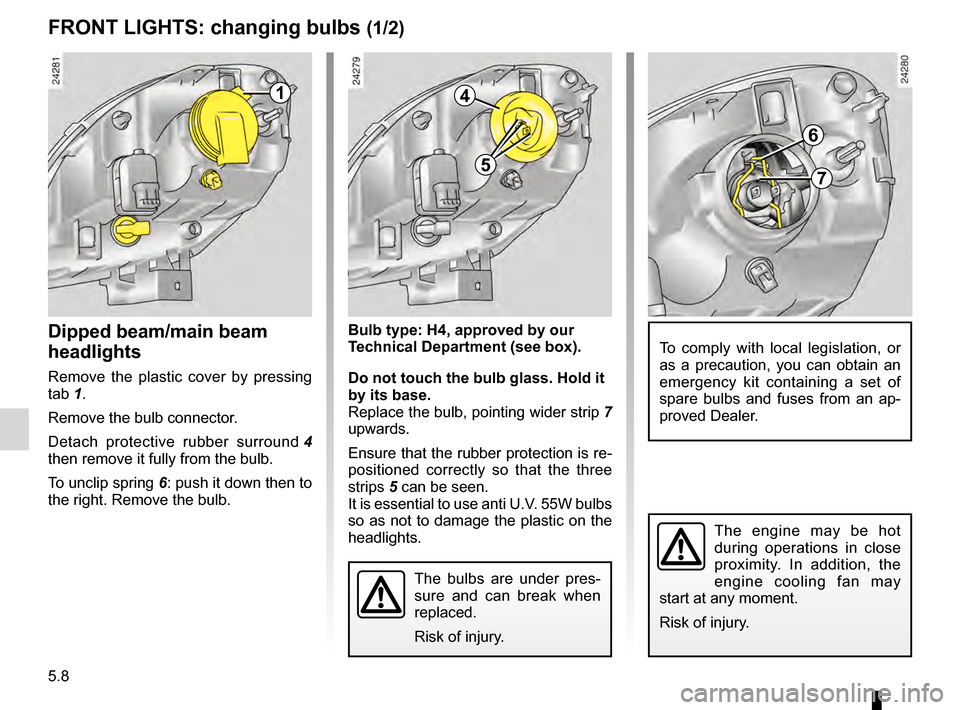
bulbschanging ......................................... (up to the end of the DU)
changing a bulb .................................... (up to the end of the DU)
practical advice ..................................... (up to the end of the DU)
front lights changing bulbs ................................ (up to the end of the DU)
bulbs changing ......................................... (up to the end of the DU)
5.8
ENG_UD7316_1
Feux avant avec lampes halogènes : remplacement des lampes (X76 - Re\
nault)
ENG_NU_854-2_X76LL_Renault_5
Jaune NoirNoir texte
Changing bulbs
Front lights
Bulb type: h4, approved by our
t echnical
Department (see box).
Do not touch the bulb glass. hold it
by
its base.
Replace the bulb, pointing wider strip 7
upwards.
Ensure that the rubber protection is re-
positioned correctly so that the three
strips
5 can be seen.
It is essential to use anti U.V. 55W bulbs
so as not to damage the plastic on the
headlights.
Dipped beam/main beam
headlights
Remove the plastic cover by pressing
tab
1.
Remove the bulb connector.
D
etach protective rubber surround 4
then remove it fully from the bulb.
T
o unclip spring 6: push it down then to
the right. Remove the bulb.
FrOnt lights : changing bulbs (1/2)
14
5
6
7
To comply with local legislation, or
as a precaution, you can obtain an
emergency kit containing a set of
spare bulbs and fuses from an ap-
proved Dealer.
The engine may be hot
during operations in close
proximity. In addition, the
engine cooling fan may
start at any moment.
Risk of injury.
The bulbs are under pres-
sure and can break when
replaced.
Risk of injury.
Page 122 of 173
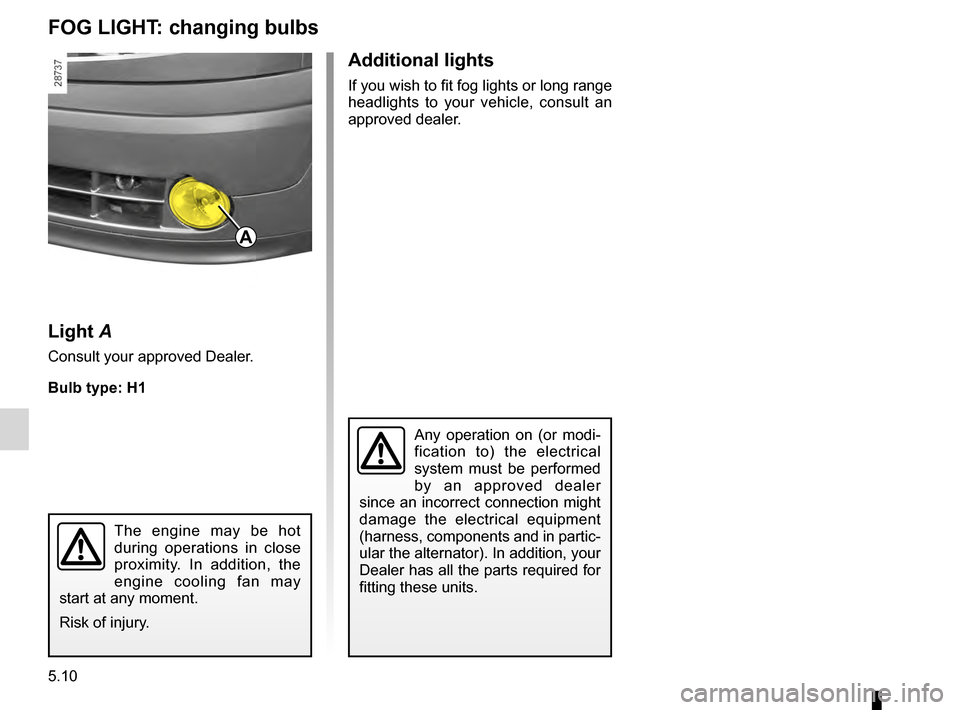
bulbschanging ......................................... (up to the end of the DU)
fog lights ............................................... (up to the end of the DU)
changing a bulb .................................... (up to the end of the DU)
bulbs changing ......................................... (up to the end of the DU)
5.10
ENG_UD7317_1
Projecteurs antibrouillard : remplacement des lampes (X76 - Renault)
ENG_NU_854-2_X76LL_Renault_5
Additional lights
If you wish to fit fog lights or long range
headlights to your vehicle, consult an
approved dealer.
Fog lights
light A
Consult your approved Dealer.
Bulb type: h1
FOg light: changing bulbs
A
The engine may be hot
during operations in close
proximity. In addition, the
engine cooling fan may
start at any moment.
Risk of injury.
Any operation on (or modi-
fication to) the electrical
system must be performed
by an approved dealer
since an incorrect connection might
damage the electrical equipment
(harness, components and in partic-
ular the alternator). In addition, your
Dealer has all the parts required for
fitting these units.
Page 131 of 173
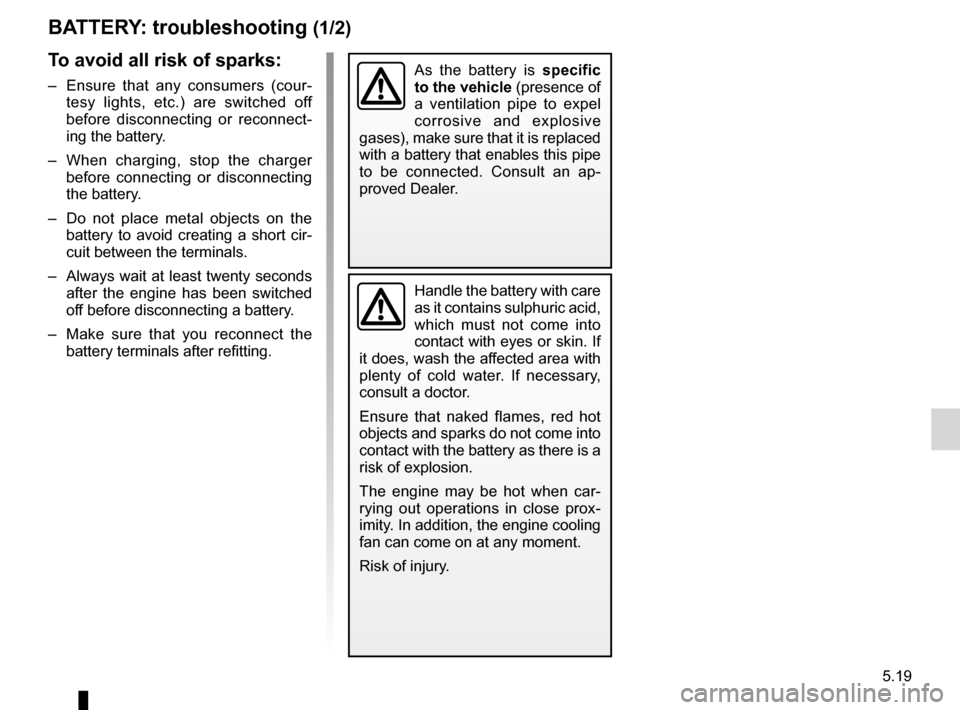
batterytroubleshooting ............................... (up to the end of the DU)
practical advice ..................................... (up to the end of the DU) 5.19
ENG_UD14324_2
Batterie : dépannage (X76 - Renault)
ENG_NU_854-2_X76LL_Renault_5
Battery: troubleshooting
BA ttEry : troubleshooting (1/2)
Handle the battery with care
as it contains sulphuric acid,
which must not come into
contact with eyes or skin. If
it does, wash the affected area with
plenty of cold water. If necessary,
consult a doctor.
Ensure that naked flames, red hot
objects and sparks do not come into
contact with the battery as there is a
risk of explosion.
The engine may be hot when car-
rying out operations in close prox-
imity. In addition, the engine cooling
fan can come on at any moment.
Risk of injury.
t o avoid all risk of sparks:
– Ensure that any consumers (cour-
tesy lights, etc.) are switched off
before disconnecting or reconnect-
ing the battery.
–
When charging, stop the charger
before connecting or disconnecting
the battery.
–
Do not place metal objects on the
battery to avoid creating a short cir-
cuit between the terminals.
–
Always wait at least twenty seconds
after the engine has been switched
off before disconnecting a battery.
–
Make sure that you reconnect the
battery terminals after refitting.
As the battery is specific
to
the vehicle (presence of
a ventilation pipe to expel
corrosive and explosive
gases), make sure that it is replaced
with a battery that enables this pipe
to be connected. Consult an ap-
proved Dealer.
Page 132 of 173

5.20
ENG_UD14324_2
Batterie : dépannage (X76 - Renault)
ENG_NU_854-2_X76LL_Renault_5
BA ttEry: troubleshooting (2/2)
Connect the positive (+) lead A to (+)
t
erminal 1 of the discharged battery,
then
to (+) terminal 2 of the battery sup-
plying the current.
C
onnect the negative (–) lead B to (–)
t
erminal 3 of the battery supplying the
current
and then to (–) terminal 4 of the
discharged battery.
Check that there is no contact between
leads
A and B and that the positive (+)
l
ead A is not touching any metal parts
on the vehicle supplying the current.
Start the engine as normal. As soon as
it
is running, disconnect leads A and B
in the reverse order (4-3-2-1)
connecting a battery charger
the battery charger must be com-
p
atible with a battery with nominal
voltage
of 12 volts.
Switch the engine off and then discon-
nect both battery leads s
tarting with
the
negative terminal .
Do not disconnect the battery when the
engine is running. Follow
the instruc-
t
ions given by the manufacturer of
the
battery charger you are using.
starting the vehicle using the
battery
from another vehicle
If you have to use the battery from an-
other vehicle to start, obtain suitable
jump leads (with a large cross section)
from an approved dealer or, if you al-
ready have jump leads, ensure that
they are in perfect condition.
t
he two batteries must have an iden -
tical
nominal voltage of 12 volts. The
battery supplying the current should
have a capacity (amp-hours, Ah) which
is at least the same as that of the dis-
charged battery.
Ensure that there is no risk of contact
between the two vehicles (risk of short
circuiting when the positive terminals
are connected) and that the discharged
battery is properly connected. Switch
off your vehicle ignition.
Start the engine of the vehicle supply-
ing the current and run it at an interme-
diate engine speed.
Special procedures may be
required to charge some
batteries. Contact your ap-
proved dealer.
Avoid all risk of sparks which may
cause an immediate explosion, and
charge the battery in a well-venti-
lated area. Risk of serious injury.
1A
2
4
B
3
Page 138 of 173
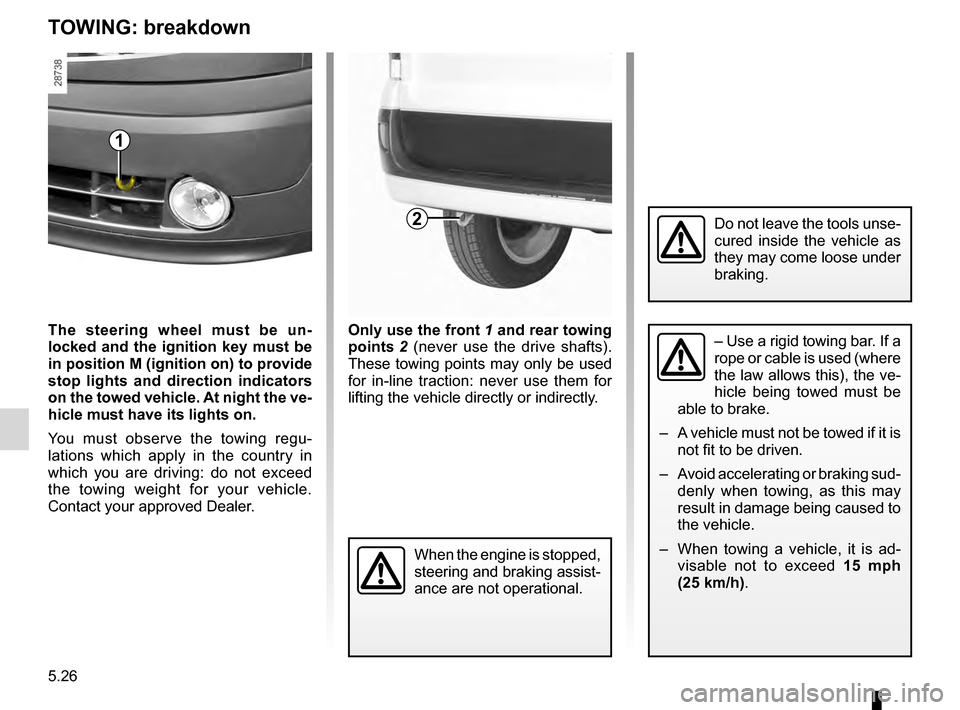
practical advice ..................................... (up to the end of the DU)
towing breakdown ...................................... (up to the end of the DU)
5.26
ENG_UD7325_1
Remorquage : dépannage (X76 - Renault)
ENG_NU_854-2_X76LL_Renault_5
Only use the front 1 and rear towing
points 2 (never use the drive shafts).
These towing points may only be used
for in-line traction: never use them for
lifting the vehicle directly or indirectly.
Towing: breakdown
When the engine is stopped,
steering and braking assist-
ance are not operational.
t he steering wheel must be un-
locked
and the ignition key must be
in
position m (ignition on) to provide
s
top lights and direction indicators
on
the towed vehicle. At night the ve-
hicle
must have its lights on.
You must observe the towing regu-
lations which apply in the country in
which you are driving: do not exceed
the towing weight for your vehicle.
Contact your approved Dealer.
tOWing: breakdown
1
2
– Use a rigid towing bar. If a
rope or cable is used (where
the law allows this), the ve-
hicle being towed must be
able to brake.
–
A vehicle must not be towed if it is
not fit to be driven.
–
Avoid accelerating or braking sud -
denly when towing, as this may
result in damage being caused to
the vehicle.
–
When towing a vehicle, it is ad -
visable not to exceed 1
5 mph
(25 km/h).
Do not leave the tools unse-
cured inside the vehicle as
they may come loose under
braking.
Page 144 of 173

filterdiesel filter ........................................................ (current page)
5.32
ENG_UD7331_1
Filtre à gazole (X76 - Renault)
ENG_NU_854-2_X76LL_Renault_5
Diesel filter
DiEsEl FiltEr
repriming the fuel circuit
If the vehicle runs out of fuel completely,
it is necessary to actuate the manual
priming bulb after having refilled.
The engine may be hot
when carrying out opera-
tions in close proximity. In
addition, the engine cooling
fan can come on at any moment.
Risk of injury.
The peripheral components (alter-
nator, starter, engine mountings,
etc.) should be protected against
splashes of fuel.
Vehicles with manual priming pump
– If fitted to the vehicle, turn the bleed
screw located on the diesel filter.
–
Actuate the repriming bulb 1 until it
hardens and fuel runs in the pipes.
1
Page 145 of 173

5.33
ENG_UD7332_1
Anomalies de fonctionnement (X76 - Renault)
ENG_NU_854-2_X76LL_Renault_5
Operating faults
OPErA ting FAults (1/4)
the following advice will enable you to carry out quick, temporary repairs. For safety reasons, you should always contact
an
approved Dealer as soon as possible.
the starter is activated POssiBlE cAusEsWhAt tO DO
Warning lights dim or fail to come on;
the starter does not run. Battery terminals disconnected,
oxidised or incorrectly secured.Retighten, reconnect or clean them if they
are oxidised.
Battery discharged or worn. Connect another battery to the faulty bat-
tery. Refer to the paragraph “Battery: trou-
bleshooting” in Section 5 or replace the bat-
tery if necessary.
Do not push the vehicle if the steering
column is locked.
The engine will not start. Starting conditions are not fulfilled. Refer to the information on “Starting/stop-
ping the engine” in Section 2.
The steering column remains locked. Steering wheel locked. To unlock, move the key and the steer-
ing wheel (refer to the information on the
“Ignition switch” in Section 2).
Page 146 of 173
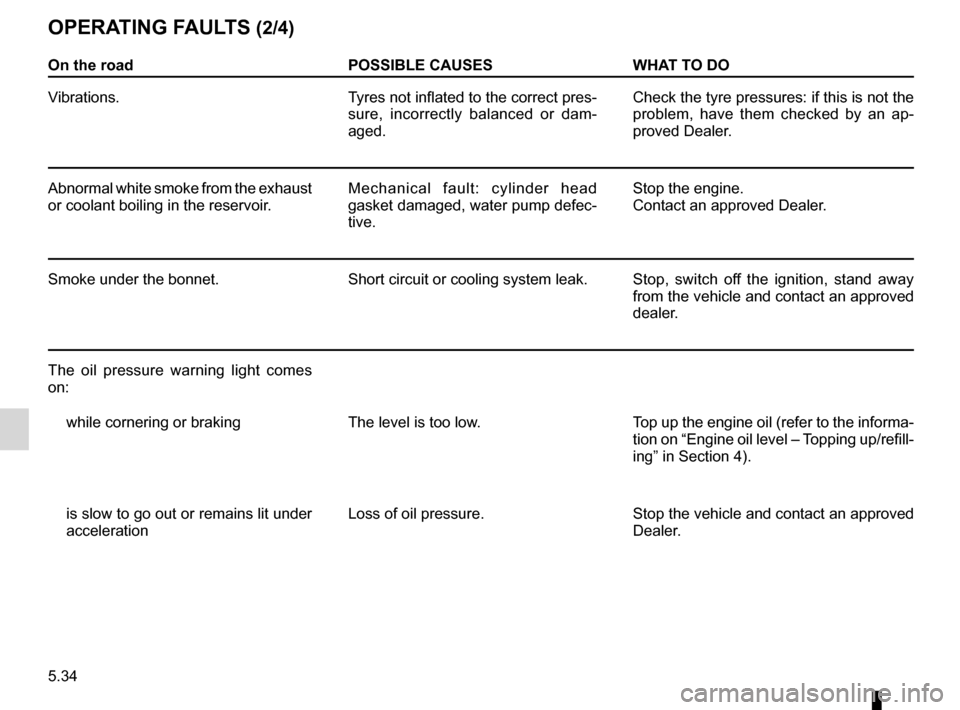
5.34
ENG_UD7332_1
Anomalies de fonctionnement (X76 - Renault)
ENG_NU_854-2_X76LL_Renault_5
Jaune NoirNoir texte
OPErA ting FAults (2/4)
On the road POssiBlE cAusEsWhAt tO DO
Vibrations. Tyres not inflated to the correct pres-
sure, incorrectly balanced or dam-
aged.Check the tyre pressures: if this is not the
problem, have them checked by an ap-
proved Dealer.
Abnormal white smoke from the exhaust
or coolant boiling in the reservoir. Mechanical fault: cylinder head
gasket damaged, water pump defec-
tive.Stop the engine.
Contact an approved Dealer.
Smoke under the bonnet. Short circuit or cooling system leak. Stop, switch off the ignition, stand away
from the vehicle and contact an approved
dealer.
The oil pressure warning light comes
on: while cornering or braking The level is too low. Top up the engine oil (refer to the informa-
tion on “Engine oil level – Topping up/refill-
ing” in Section 4).
is slow to go out or remains lit under
acceleration Loss of oil pressure.
Stop the vehicle and contact an approved
Dealer.
Page 147 of 173
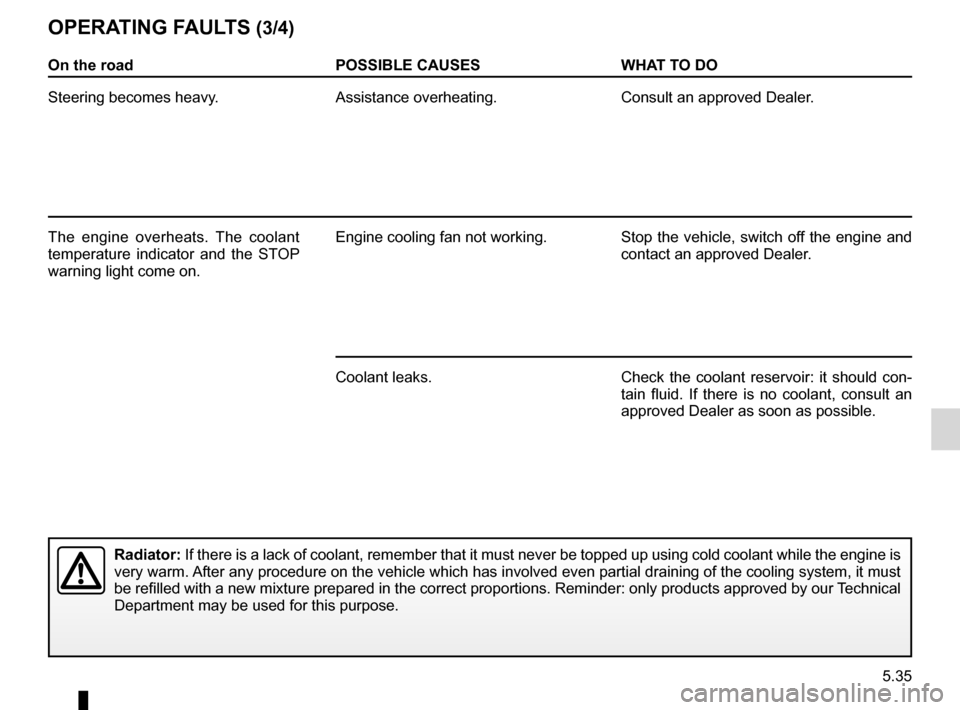
JauneNoirNoir texte
5.35
ENG_UD7332_1
Anomalies de fonctionnement (X76 - Renault)
ENG_NU_854-2_X76LL_Renault_5
OPErA ting FAults (3/4)
On the road POssiBlE cAusEsWhAt tO DO
Steering becomes heavy. Assistance overheating.Consult an approved Dealer.
The engine overheats. The coolant
temperature indicator and the STOP
warning light come on. Engine cooling fan not working. Stop the vehicle, switch off the engine and
contact an approved Dealer.
Coolant leaks. Check the coolant reservoir: it should con-
tain fluid. If there is no coolant, consult an
approved Dealer as soon as possible.
radiator: If there is a lack of coolant, remember that it must never be topped up using cold coolant while the engine is
very warm. After any procedure on the vehicle which has involved even partial draining of the cooling system, it must
be refilled with a new mixture prepared in the correct proportions. Reminder: only products approved by our Technical
Department may be used for this purpose.
Page 149 of 173
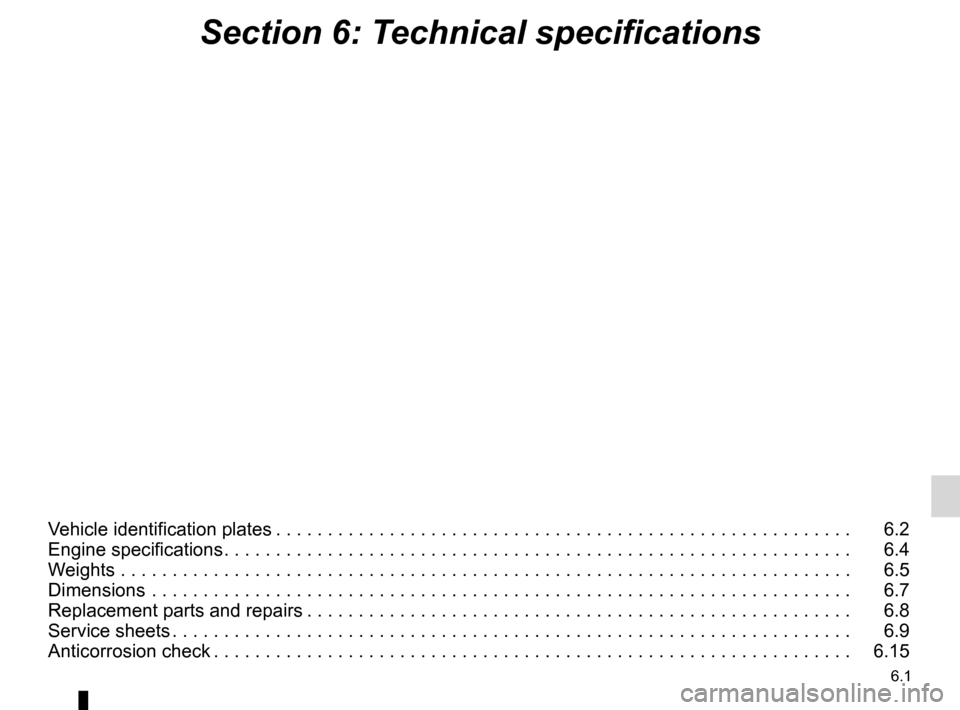
6.1
ENG_UD14023_2
Sommaire 6 (X76 - Renault)
ENG_NU_854-2_X76LL_Renault_6
Section 6: Technical specifications
Vehicle identification plates . . . . . . . . . . . . . . . . . . . . . . . . . . . . . . . . . . . . \
. . . . . . . . . . . . . . . . . . . . 6.2
Engine specifications . . . . . . . . . . . . . . . . . . . . . . . . . . . . . . . . . . . . \
. . . . . . . . . . . . . . . . . . . . . . . . . 6.4
Weights . . . . . . . . . . . . . . . . . . . . . . . . . . . . . . . . . . . .\
. . . . . . . . . . . . . . . . . . . . . . . . . . . . . . . . . . . 6.5
Dimensions . . . . . . . . . . . . . . . . . . . . . . . . . . . . . . . . . . . .\
. . . . . . . . . . . . . . . . . . . . . . . . . . . . . . . . 6.7
Replacement parts and repairs . . . . . . . . . . . . . . . . . . . . . . . . . . . . . . . . . . . . \
. . . . . . . . . . . . . . . . . 6.8
Service sheets . . . . . . . . . . . . . . . . . . . . . . . . . . . . . . . . . . . . \
. . . . . . . . . . . . . . . . . . . . . . . . . . . . . . 6.9
Anticorrosion check . . . . . . . . . . . . . . . . . . . . . . . . . . . . . . . . . . . . \
. . . . . . . . . . . . . . . . . . . . . . . . . . 6.15